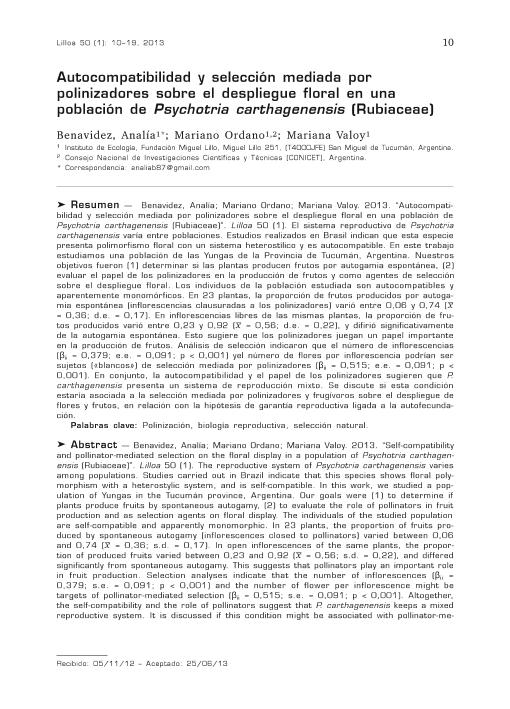Mostrar el registro sencillo del ítem
dc.contributor.author
Benavídez, Analía

dc.contributor.author
Ordano, Mariano Andrés

dc.contributor.author
Valoy, Mariana
dc.date.available
2016-08-26T15:22:32Z
dc.date.issued
2013-06
dc.identifier.citation
Benavídez, Analía; Ordano, Mariano Andrés; Valoy, Mariana; Autocompatibilidad y selección mediada por polinizadores sobre el despliegue floral en una población de Psychotria carthagenensis Jacq. (Rubiaceae); Fundación Miguel Lillo; Lilloa; 50; 1; 6-2013; 10-19
dc.identifier.issn
0075-9481
dc.identifier.uri
http://hdl.handle.net/11336/7313
dc.description.abstract
El sistema reproductivo de Psychotria carthagenensis varía entre poblaciones. Estudios realizados en Brasil indican que esta especie presenta polimorfismo floral con un sistema heterostílico y es autocompatible. En este trabajo estudiamos una población de las Yungas de la Provincia de Tucumán, Argentina. Nuestros objetivos fueron (1) determinar si las plantas producen frutos por autogamia espontánea, (2) evaluar el papel de los polinizadores en la producción de frutos y como agentes de selección sobre el despliegue floral. Los individuos de la población estudiada son autocompatibles y aparentemente monomórficos. En 23 plantas, la proporción de frutos producidos por autogamia espontánea (inflorescencias clausuradas a los polinizadores) varió entre 0,06 y 0,74 (É = 0,36; d.e. = 0,17). En inflorescencias libres de las mismas plantas, la proporción de frutos producidos varió entre 0,23 y 0,92 (É = 0,56; d.e. = 0,22), y difirió significativamente de la autogamia espontánea. Esto sugiere que los polinizadores juegan un papel importante en la producción de frutos. Análisis de selección indicaron que el número de inflorescencias (âii = 0,379; e.e. = 0,091; p < 0,001) y el número de flores por inflorescencia podrían ser sujetos («blancos») de selección mediada por polinizadores (â ii = 0,515; e.e. = 0,091; p < 0,001). En conjunto, la autocompatibilidad y el papel de los polinizadores sugieren que P. carthagenensis presenta un sistema de reproducción mixto. Se discute si esta condición estaría asociada a la selección mediada por polinizadores y frugívoros sobre el despliegue de flores y frutos, en relación con la hipótesis de garantía reproductiva ligada a la autofecundación.
dc.description.abstract
The reproductive system of Psychotria carthagenensis varies among populations. Studies carried out in Brazil indicate that this species shows floral polymorphism with a heterostylic system, and is self-compatible. In this work, we studied a population of Yungas in the Tucumán province, Argentina. Our goals were (1) to determine if plants produce fruits by spontaneous autogamy, (2) to evaluate the role of pollinators in fruit production and as selection agents on floral display. The individuals of the studied population are self-compatible and apparently monomorphic. In 23 plants, the proportion of fruits produced by spontaneous autogamy (inflorescences closed to pollinators) varied between 0,06and 0,74 (¢ = 0,36; s.d. = 0,17). In open inflorescences of the same plants, the proportion of produced fruits varied between 0,23 and 0,92 (¢ = 0,56; s.d. = 0,22), and differed significantly from spontaneous autogamy. This suggests that pollinators play an important role in fruit production. Selection analyses indicate that the number of inflorescences (βii = 0,379; s.e. = 0,091; p < 0,001) and the number of flower per inflorescence might be targets of pollinator-mediated selection (βii = 0,515; s.e. = 0,091; p < 0,001). Altogether, the self-compatibility and the role of pollinators suggest that P. carthagenensis keeps a mixed reproductive system. It is discussed if this condition might be associated with pollinator-mediated and frugivore mediated selection on floral and fruit display, in relation with the reproductive assurance hypothesis linked to self-fecundation
dc.format
application/pdf
dc.language.iso
spa
dc.publisher
Fundación Miguel Lillo
dc.rights
info:eu-repo/semantics/openAccess
dc.rights.uri
https://creativecommons.org/licenses/by-nc-sa/2.5/ar/
dc.subject
Polinización
dc.subject
Biología Reproductiva
dc.subject
Selección Natural
dc.subject.classification
Biología

dc.subject.classification
Ciencias Biológicas

dc.subject.classification
CIENCIAS NATURALES Y EXACTAS

dc.title
Autocompatibilidad y selección mediada por polinizadores sobre el despliegue floral en una población de Psychotria carthagenensis Jacq. (Rubiaceae)
dc.type
info:eu-repo/semantics/article
dc.type
info:ar-repo/semantics/artículo
dc.type
info:eu-repo/semantics/publishedVersion
dc.date.updated
2016-08-11T19:39:47Z
dc.journal.volume
50
dc.journal.number
1
dc.journal.pagination
10-19
dc.journal.pais
Argentina

dc.journal.ciudad
San Miguel de Tucumán
dc.description.fil
Fil: Benavídez, Analía. Fundacion Miguel Lillo. Direccion de Botanica. Instituto de Ecologia Vegetal; Argentina
dc.description.fil
Fil: Ordano, Mariano Andrés. Fundacion Miguel Lillo. Direccion de Botanica. Instituto de Ecologia Vegetal; Argentina. Consejo Nacional de Investigaciones Científicas y Técnicas. Centro Científico Tecnológico Tucumán; Argentina
dc.description.fil
Fil: Valoy, Mariana. Fundacion Miguel Lillo. Direccion de Botanica. Instituto de Ecologia Vegetal; Argentina
dc.journal.title
Lilloa
dc.relation.alternativeid
info:eu-repo/semantics/altIdentifier/url/http://lillo.org.ar/content/view/1074/120/
Archivos asociados
